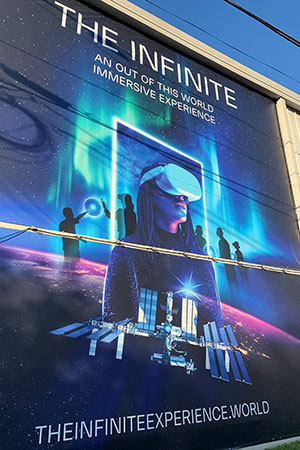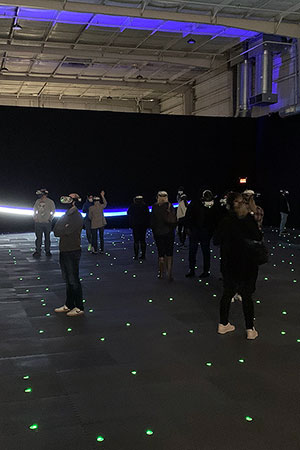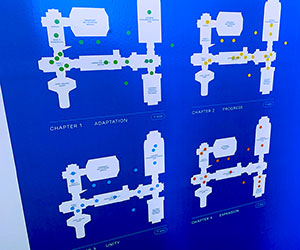December 21, 2021 — There is a moment in The Infinite, if you are standing in the right place at the right time, where you can find yourself in front of NASA astronaut Drew Morgan as he tries to describe what it is like to come on board the International Space Station for the first time. Try as he might, he cannot find the words to properly capture the feeling.
"Amazing ... incredible," he says, as he rattles off adjectives that just do not do the moment justice.
"It is a spiritual experience," he concludes.
Morgan — or at least a virtual reality, 3D recording of Morgan — is attempting to share what he felt in July of 2019, as he became a member of the space station's 60th expedition crew. His words resonate, but for an added reason that he was unable of knowing at the time.
For Morgan is not only describing his own experience; he was also unknowingly voicing what many, if not all of the people standing in the 6,000-square-foot [650-sq.-meter] event space watching him are going through at that instant as well.
Welcome to The Infinite, an immersive VR installation that transports participants from the ground — in this case, downtown Houston — to Earth orbit for a half hour walking tour of the space station, followed by an eight-minute seated spacewalk that is like nothing anyone who is not an astronaut has seen before.
"It's a step into the metaverse, you know the buzzword everybody's talking about," Stéphane Rituit, co-founder and chief executive officer of Felix & Paul Studios, the creative team behind the space-based footage in The Infinite, said in an interview with collectSPACE. "Here you can interact. You, coming with your friends and family, have your avatar, you see them evolving in space, you walk into the inside of the space station, inside and outside the space station, and you decide which content you watch at any time."
The Infinite, which is produced in collaboration with PHI Studio, is based on Felix & Paul's Emmy Award-winning "Space Explorers: The ISS Experience," the largest ever media project to be filmed in space, created in partnership with TIME Studios. For two and a half years, astronauts on the real space station used a special camera rig to capture themselves and their surroundings in high definition, 3D, 360-degree virtual reality.
"Space Explorers," which is available for the Oculus line of VR headsets, offers a multi-chapter, cinematic presentation for individuals to experience at home alone. The Infinite builds off that by placing the scenes from "Space Explorers" into the context of a full-scale, VR reproduction of the station, which up to 150 people can explore together at a time.
"You don't see everything because there are 65 videos to watch — two hours of content — and when you come here you get 35 minutes. But then, when you get out, there's so much you can talk about each other's experience with your friends and family," Rituit said.
It also creates a compelling reason to come back again, as if spending 35 minutes "in space" is not reason enough.
The Infinite debuted in Montreal in July, where it ran for four months. It opened in Houston on Monday (Dec. 20), marking its U.S. premiere and the world's first look at a spacewalk filmed in virtual reality.
First, though, you have to take your seat. After walking through the modules — literally and, well, literally: you can choose to follow the paths set forth by the walls of the station's rooms or you can walk through the walls and discover scenes filmed outside of the outpost — a voice instructs everyone to follow a lighted path into a virtual room where virtual seats line up with real life cushioned chairs.
"We felt that at some point, we wanted audiences to have a calmer moment at the end," said Félix Lajeunesse, co-founder, creative director and the "Felix" in Felix & Paul Studios. "And because it is a spacewalk. you spend eight minutes being transported on a gigantic robotic arm in the vacuum of space. You look down you see planet Earth, you look around, you see the gigantic space station and the astronauts — there's something vertiginous about it."
"So we thought if we have people sitting down, and not only sitting down, but even leaning back a little bit, feeling that you are enveloped and that you're in a safe environment, you might be able to really let go and experience the spacewalk," Lajeunesse told collectSPACE.
The spacewalk is all at once both exhilarating and awe-inspiring. As a pair of astronauts work to configure the mount for a new solar array, your attention cannot help but be drawn to Earth rotating above, or below, depending on your perspective. It is the ultimate giant screen film, but without any edges to bring you back to reality.
The Infinite ends with an art installation by visual and sound artist Ryoji Ikeda, but the space station is the highlight of the visit. It is the closest that most people will ever get to visiting the orbiting laboratory, which for more than 20 years have been continuously crewed.
The Infinite is now open at Sawyer Yards in downtown Houston through Feb. 20. The public can save $7 off the $36 admission ticket by booking a visit on or before Jan. 12. Children under the age of 8 are not admitted. Children between 8 and 12 years old must be accompanied by an adult and a waiver must be signed if using an Oculus headset. |
|

The Infinite, a VR experience offering interactive, immersive tours of the International Space Station, is now open in Houston, Texas, marking its premiere in the United States. (collectSPACE)

"Astronauts" exploring the International Space Station: Visitors to The Infinite in Houston wear Oculus VR headsets to walkthrough a full-scale reproduction of the orbiting complex. (collectSPACE)

There are 65 VR clips to discover in The Infinite, spread across four chapters, which are positioned around (both inside and outside) the International Space Station. (collectSPACE) |
